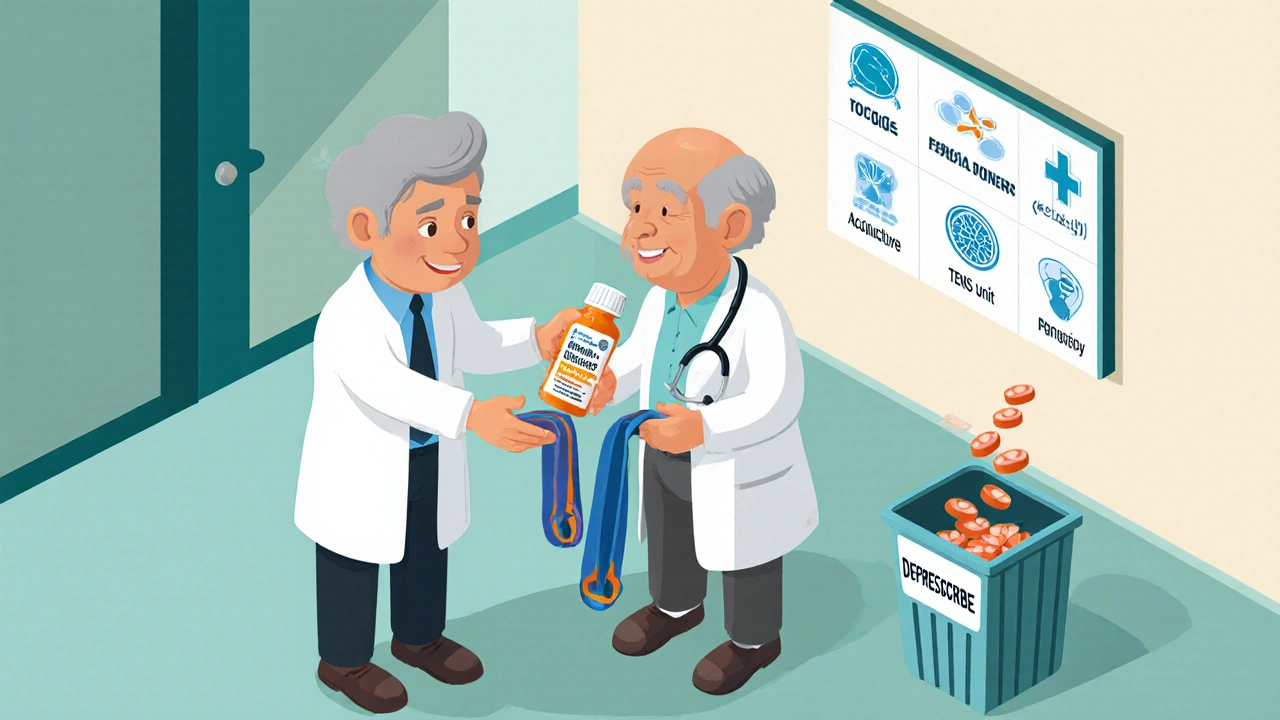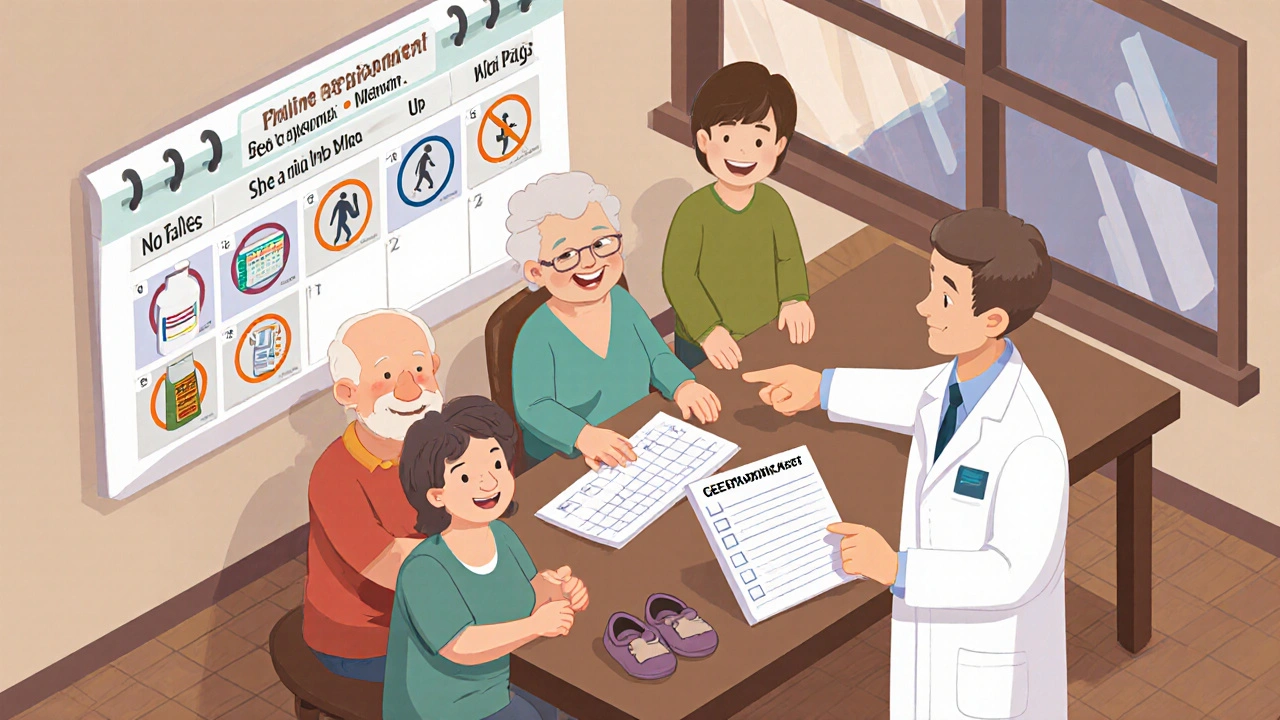Older Adult Opioid Safety Calculator
Calculate Safe Opioid Dose
Results & Recommendations
Enter your information above to see personalized recommendations.
High Risk Alert
Safe Dose Range
Non-Opioid Alternatives
Consider these options from the article:
- Physical therapy for strength and balance
- Topical NSAIDs (e.g., diclofenac gel)
- Acupuncture for chronic pain
- Cognitive behavioral therapy
Why Opioids Are Riskier for Older Adults
Older adults don’t process opioids the same way younger people do. As we age, our kidneys and liver slow down. Body fat increases while muscle mass decreases. The blood-brain barrier becomes more porous. These changes mean even a standard dose meant for a 40-year-old can overwhelm an 80-year-old. The result? Sedation, confusion, dizziness, and a much higher chance of falling.
A 2011 study found that, on average, 80 adults aged 65 and older visited the emergency room every day because of problems with narcotic pain relievers. Seven of those visits involved heroin. That’s not just about misuse-it’s about how easily these drugs go wrong in older bodies. Emergency visits for opioid-related issues in this group jumped by over 112% between 2005 and 2014. Hospital stays rose by 85%. The numbers don’t lie: opioids are dangerous for seniors, and the risks are growing.
Falls: The Silent Epidemic
Falls are the leading cause of injury and death in older adults. Opioids make them far more likely. How? Three main ways: sedation, orthostatic hypotension (a sudden drop in blood pressure when standing), and dizziness. Even weak opioids like tramadol can cause hyponatremia-low sodium levels-which leads to confusion, drowsiness, and loss of balance.
One study of 2,341 adults over 60 found that those taking opioids had a 6% fracture rate over 33 months, compared to 4% for those not on opioids. The difference wasn’t statistically significant, but that doesn’t mean it’s not real. Many fractures go unreported. And when a fall happens, recovery is harder. A hip fracture in an older adult can mean the end of independent living.
Tramadol is especially tricky. It’s often prescribed because it’s seen as "safer," but it’s metabolized by enzymes (CYP2D6 and CYP3A4) that vary widely in older adults. Add another medication-like an antidepressant or an antifungal-and you can double the sedative effect. That’s why many geriatricians now avoid tramadol entirely in seniors.
Delirium: When Pain Medication Causes Confusion
Delirium isn’t just "being confused." It’s a sudden, severe change in mental state-trouble focusing, hallucinations, agitation, or extreme drowsiness. In older adults, especially those with dementia, opioids are a leading trigger.
A 2023 study from the Danish Dementia Research Centre followed 75,471 people over 65 with dementia. Those who started opioids within two weeks of diagnosis were eleven times more likely to die than those who didn’t. The risk was highest in the first few days. That’s not a coincidence. Opioids depress brain activity. In a brain already struggling with dementia, even a small dose can tip the balance.
Doctors often mistake delirium for worsening dementia. Patients are put on higher doses instead of having the opioid stopped. It’s a vicious cycle. One study showed that nearly half of primary care doctors felt unsure how to taper opioids safely. And many older adults don’t realize their confusion is drug-related-they think it’s just "getting older."

Dose Adjustments: Start Low, Go Slow
There’s no one-size-fits-all dose for older adults. The rule is simple: start low, go slow. That means beginning with 25% to 50% of the dose you’d give a younger adult. For example, if a typical starting dose for a 50-year-old is 10 mg of oxycodone every 6 hours, an 80-year-old might start with 2.5 mg every 8 hours.
It’s not just about the initial dose. Monitoring matters more. Check for signs of sedation: slurred speech, trouble staying awake, nodding off while sitting. Watch for balance issues-does the person need help standing? Are they dragging their feet? Ask: "Are you feeling dizzy when you stand up?" Don’t wait for them to bring it up. Most won’t.
Long-acting opioids like extended-release morphine or fentanyl patches are especially risky. They build up in the system over time. For seniors, immediate-release options are usually safer. And never combine opioids with benzodiazepines, sleep aids, or alcohol. That combination is a recipe for respiratory failure.
Deprescribing: When It’s Time to Stop
Many older adults have been on opioids for years. Maybe it started after surgery. Maybe for back pain. Now, they’re on it because "it’s always worked." But the risks have grown. The pain may have changed. The body has changed. The drug may no longer help-and it’s definitely hurting.
Deprescribing isn’t about taking away pain relief. It’s about finding safer ways to manage it. The STOPPFall tool helps doctors decide when to reduce or stop opioids in people who’ve fallen or are at risk. It looks at fall history, cognitive status, other medications, and pain severity-not just the dose.
Stopping opioids can be hard. Physical dependence can develop in as little as a few days. Withdrawal symptoms-sweating, anxiety, nausea, insomnia-can be mistaken for illness. That’s why tapering must be gradual. Reduce by 10% every week or two. Watch closely. Keep the patient involved. If they’re scared, explain: "This isn’t about taking away your comfort. It’s about keeping you safe and clear-headed."
Non-Opioid Alternatives That Actually Work
Before reaching for an opioid, ask: "Are there other options?" Often, the answer is yes.
- Physical therapy: Strength and balance training reduce fall risk and improve pain tolerance.
- Acupuncture: Studies show it helps with chronic back and knee pain in seniors.
- Topical NSAIDs: Creams like diclofenac gel work locally with almost no systemic side effects.
- Cognitive behavioral therapy: Helps change how pain is perceived. Works better than opioids for many with chronic pain.
- Heat, cold, massage, TENS units: Simple, low-cost, and effective for many types of pain.
One study found that seniors who used a combination of physical therapy and non-opioid meds had better pain control and fewer falls than those on opioids alone. Pain doesn’t always need a pill. Sometimes, it needs movement, support, and time.

The Communication Gap
Doctors worry about falls, confusion, and overdose. Older adults worry about addiction. But most don’t know the difference between addiction and physical dependence. They don’t realize that needing a medication to avoid withdrawal isn’t the same as craving it.
One study found that nearly half of primary care physicians felt unprepared to talk about tapering opioids. Patients often feel dismissed. If a doctor says, "We need to cut back," without explaining why, trust breaks down.
Start the conversation with empathy: "I know this medicine helped you. I’m not taking it away-I’m trying to find a way to keep you safe and feeling your best. Let’s look at other options together."
What Families Should Watch For
If you’re caring for an older relative on opioids, pay attention to these signs:
- They’re sleeping more than usual or can’t stay awake during the day
- They’re confused or forgetful in ways that are new
- They’ve had a fall, even a small one
- They’re less interested in food, socializing, or activities they used to enjoy
- They’re taking more than one pain medicine-especially if it includes sleeping pills or anxiety meds
Don’t wait for a crisis. Talk to their doctor. Bring a list of all medications, including over-the-counter ones. Ask: "Is this still the safest option?" and "What happens if we try reducing it?"
Final Thoughts: Safety Over Speed
Opioids aren’t evil. For some older adults with severe, uncontrolled pain-like advanced cancer-they’re necessary. But for most chronic pain conditions, the risks outweigh the benefits. The goal isn’t to eliminate pain completely. It’s to manage it in a way that keeps people mobile, alert, and independent.
The tide is turning. More doctors are using tools like STOPPFall and START/STOPP guidelines. More families are asking questions. More seniors are choosing non-drug options. But change takes time. The legacy of overprescribing means many older adults are still on opioids they no longer need.
Be the one who asks. Be the one who checks. Be the one who says: "There’s a better way."
Can opioids cause dementia in older adults?
Opioids don’t cause dementia, but they can worsen confusion and memory problems in people who already have it. A 2023 study found that seniors with dementia who started opioids had an elevenfold higher risk of death in the first two weeks. This isn’t because opioids cause dementia-it’s because they make brain function worse in an already vulnerable brain. The confusion they cause can look like dementia, leading to misdiagnosis and higher doses.
Is tramadol safe for seniors?
Tramadol is generally not recommended for older adults. It can cause hyponatremia (low sodium), which leads to dizziness, confusion, and falls. It’s also metabolized by enzymes that become less reliable with age, making dosing unpredictable. When combined with other medications, the risk of sedation and respiratory depression increases. Most geriatric pain specialists avoid tramadol entirely in patients over 70.
How long does it take to become dependent on opioids?
Physical dependence can develop in as little as 3 to 7 days, even with proper use. This is not addiction-it’s the body adapting to the drug. Stopping suddenly can cause withdrawal symptoms like sweating, nausea, anxiety, and insomnia. That’s why tapering must be slow and supervised. Many older adults don’t realize they’re dependent because they don’t have cravings. They just feel unwell when they miss a dose.
What should I do if my parent is on opioids and falling?
Don’t wait. Schedule a medication review with their doctor. Bring a list of all prescriptions, supplements, and over-the-counter drugs. Ask specifically about the STOPPFall tool and whether opioids could be contributing to the falls. Suggest non-opioid alternatives like physical therapy or topical pain relief. If the doctor resists, ask for a referral to a geriatrician or pain specialist. Falls in older adults are not normal-they’re a warning sign.
Are there any safe opioids for seniors?
No opioid is completely safe for older adults, but some are less risky than others. Short-acting, immediate-release opioids like oxycodone or hydrocodone, at very low doses, are preferred over long-acting or patch forms. Morphine and codeine are generally avoided due to active metabolites that build up in aging kidneys. The safest opioid is the one that’s not used at all-unless the pain is severe and other options have failed.
Peter Stephen .O
November 17, 2025 AT 14:36Andrew Cairney
November 18, 2025 AT 14:33Rob Goldstein
November 19, 2025 AT 01:19vinod mali
November 19, 2025 AT 12:27Jennie Zhu
November 20, 2025 AT 16:55Kathy Grant
November 22, 2025 AT 08:34Robert Merril
November 24, 2025 AT 03:43Noel Molina Mattinez
November 24, 2025 AT 18:31